Dicenter - planting and care in the open field: the nuances of growing from rhizomes and seeds
Dicentra, also popularly called "broken heart" (due to the shape of the flower), is an exotic plant that can now be found in many flower beds in garden plots. Florists loved this flower not only because of its original shape, but also because of its light, pleasant aroma. And if you, too, turned out to be partial to this adorable plant, check out the different ways of its propagation and the features of planting by seeds, rhizomes, care in pots and open ground, as well as pruning and shelter for the winter.
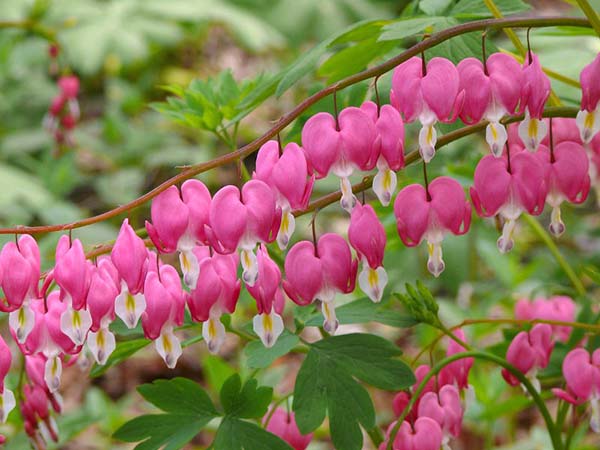
Content
Types and varieties of dicentra
The genus dicenter has 8 species (according to other sources, 9), but the following 4 types are most popular (the first two are the most common):
- Gorgeous (90 cm and above);
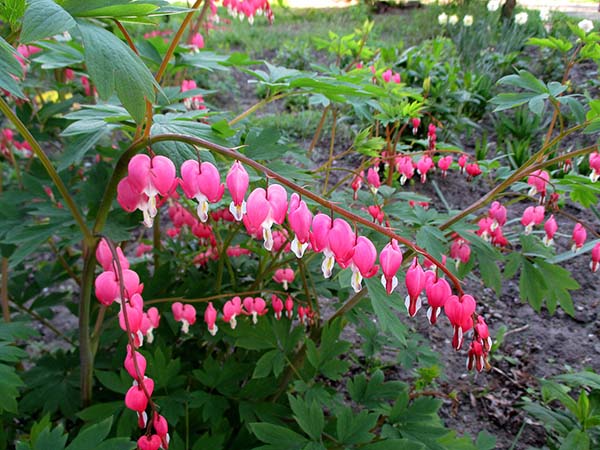
By the way! The magnificent dicenter is called "Broken heart«.
- Beautiful (up to 25-40 cm in height);
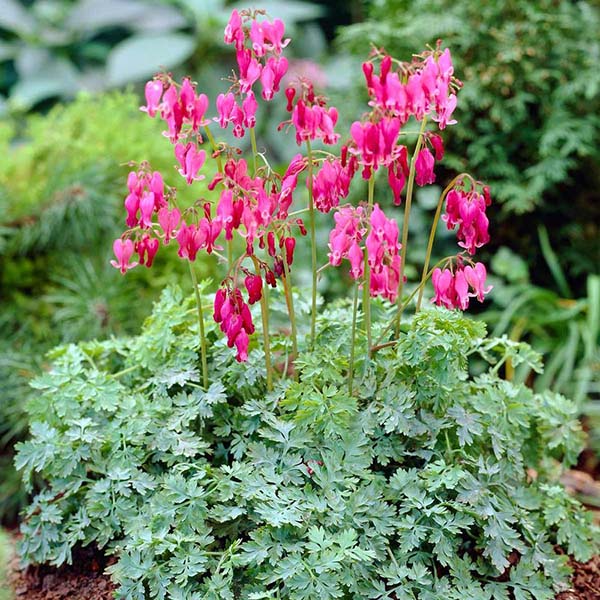
Note! A feature of the dicenter magnificent is the fact that when it fades (it does not bloom for a very long time, usually only in May or June), its foliage begins to turn yellow and die off, and then the stems. In other words, it actually disappears (its aboveground part). This is absolutely normal, next spring it will reappear and bloom.
And here is the dicenter beautiful blooms much longer (from May to August, sometimes even to October) and does not die off immediately after flowering.
- Exceptional;
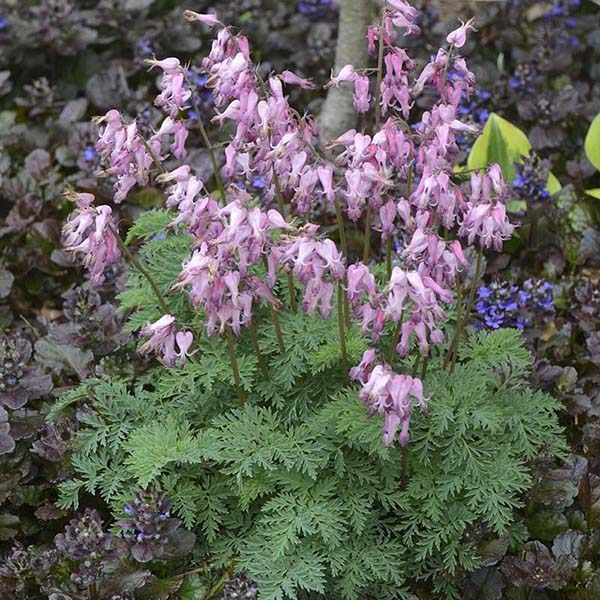
- Curly or climbing (popular yellow-flowered varieties - Golden tears, Golden drops).
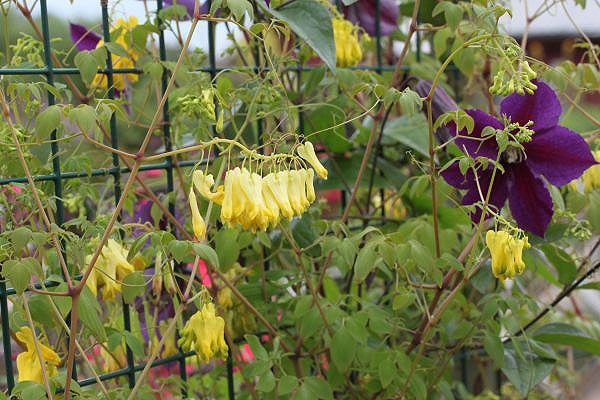
There are also hybrid dicenters with two-color inflorescences.
Video: flowering dicentra beautiful
Methods for growing and breeding a dicenter
The dicenter can be grown as from seed by sowing them on seedlings, and from the roots (with pre-germination at home in a pot). The second method (from rhizomes) is much simpler, and such a dicentra can begin to bloom in the first year, if it takes root normally. But it is still better to remove the first buds and let them bloom only the next year.
In general, the dicenter is excellent reproduces by self-seeding... And you can help her: when your plants have faded, the pods (seed crusts) will ripen, you just need to loosen the soil a little under the bush and pour the seeds there. And when the young seedlings grow up a little, then transplant it to the place you need.
Growing dicentra from seeds
It is very convenient and practical to sow the seeds of the bleeding center before winter, so that they undergo natural stratification.
By the way! Podwinter sowing of dicentra is carried out in almost the same way sowing asters before winter.
Of course, you can grow seedlings at home (sometime in February) by artificial stratification - by sowing seeds under the snow, and then removing the planting container for a while in the refrigerator or hiding it directly in the garden (in a snowdrift). Further, when the plants grow up, they should be dived into deeper containers. And at the end of spring, when return frosts pass, plant it in open ground.
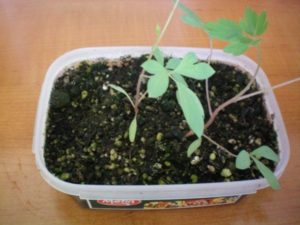
By the way! You can try sowing seeds without stratification, for example, in peat tablets (many manufacturers recommend this method).
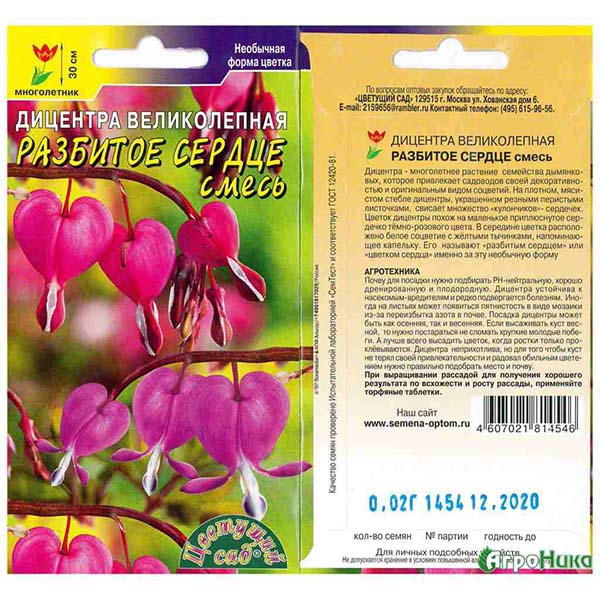
Worth knowing! Dicentra grown from seeds blooms only for 3 years.
Growing dicenter from rhizomes: processing and preliminary planting in a pot
As a rule, in garden centers you can most often find the sale of the rhizomes of the dicentra. Further, detailed instructions will be given on their preparation and planting in open ground.
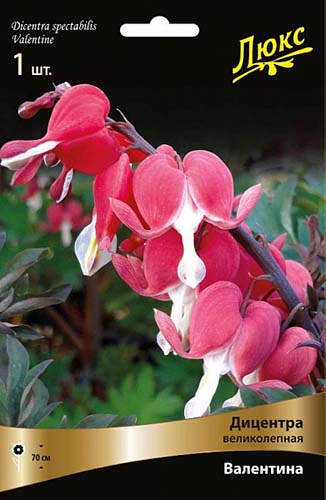
What to do after buying rhizomes: how to store them
If you bought rhizomes in early spring, then in no case do not store them in the refrigerator, there they can rot and / or pick up some kind of disease. Moreover, you should not do this if small sprouts have already appeared, in such conditions they will only stretch out.
Here's what you need to do - process the rhizomes in one of the fungicides, plant in a pot, and then, when a stable positive temperature is established, plant in open ground.
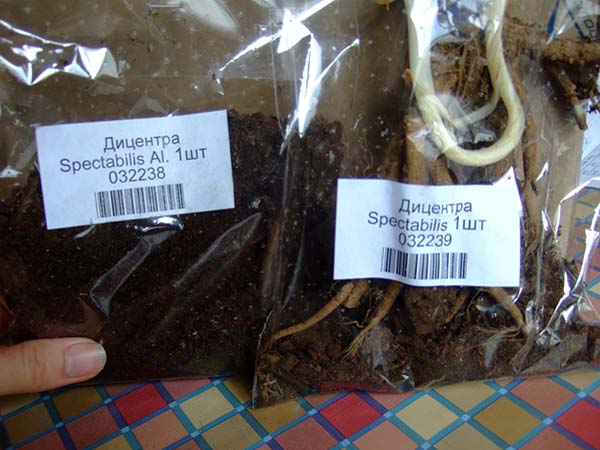
Preparation of rhizomes (treatment in fungicide)
Purchased rhizomes should carefully examine and trim all rotten roots.
And then, before planting the rhizomes of the dicenter in the ground, they must be treated in one of the fungicides, for example, in Fitosporin, Gamaira, Maxim, Fundazole or Vitaros.
Dissolve the drug in water at room temperature and keep the roots in the solution for 20 to 60 minutes (according to the instructions for a specific drug).
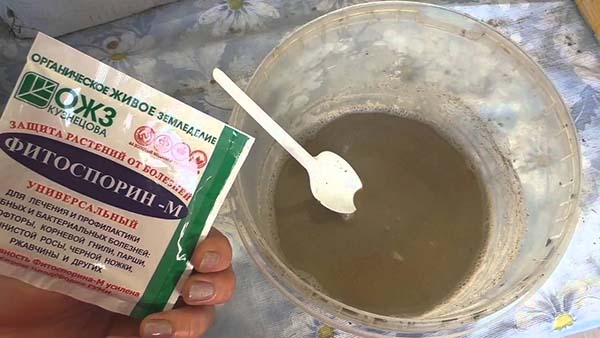
Advice! It is also advisable to additionally process the places of cuts that remained after dividing the roots with brilliant green.
Preplanting in a pot (for germination)
After soaking the roots in one of the fungicides, they need to be placed in a pot for germination, where the rhizomes of the dicentra will awaken and will certainly give shoots (perhaps even bloom) even before planting in open ground.
Choose a pot based on the size of the roots. Also, there must be drainage holes and drainage itself (the same expanded clay) at the bottom.
Remember! Drainage (expanded clay) does not allow drainage holes to clog.
Planting the roots of the dicentra in a pot (for germination) is carried out as follows:
- Put the roots in a pot, and in such a way that sprouts (buds) looked exactly uprather than sideways (for example, lay them obliquely).
Important! In no case should the roots in the pot be bent. If the roots do not get in the way of the planting container, it is better to trim them with a sharp knife.
- Cover the roots with loose soil, combining with watering.
So that voids do not form in the pot, it is worth laying layer of earththen execute abundant wateringand then fill up the soil again. And so repeatuntil the entire pot is full (no roots sticking out of the ground). The topmost layer is dry soil so that a crust does not form after watering.
- Depending on what kind of sprouts you have, (especially if they are already 3-5 cm long), the pot can be covered with a bag or film on top to create a greenhouse effect, and the plant began to take root faster in a new place and feed the sprouts.
If you bought a rhizome in late winter or early spring, then, as a rule, it is in a normal state - it has very small shoots (buds). In this case, he does not need any shelter (greenhouse conditions).
- Place in a warm room, where the temperature is above +20 degrees (for 1-2 weeks), so that the plant takes root.
If the rhizomes were not in very good condition (so to speak, "half rot"), then a tablet of glyocladine should be placed in the pot, or periodically watered with a solution phytosporin.
- And then rearrange it to a cooler place (below + 20 degrees, but not below +10).
Advice! If the dicenter begins to bloom before planting in open ground, i.e. still in a pot, you need to cut off the peduncles with your own hands. All the same, they will be frail, but now the main thing is that a good root system develops.
Video: planting and growing a dicenter or a broken heart
When and how to plant a dicenter in open ground
It is necessary to plant a dicenter only after return frosts, i.e. for example, in the Middle zone (Moscow region) around the second half of May, but not earlier.
In principle, it is possible to plant seedlings in autumn (in September), but it is optimal in late spring or early summer.
Place in the garden
The center is very easy to find a place in the garden, because it can grow both in the shade and in the sun. However, it is optimal to plant it in partial shade. There she will feel best of all - bloom earlier and bloom longer, and also grow stronger. Of course, you can plant it in the sunniest area, where the plant will bloom more abundantly, but for a shorter period and the bushes themselves will not be very deciduous.
By the way! Many people plant the dicenter under trees (including in the trunk circles). But in this case, in spring and summer, you need to remember to water them more often - there is always less moisture under the trees
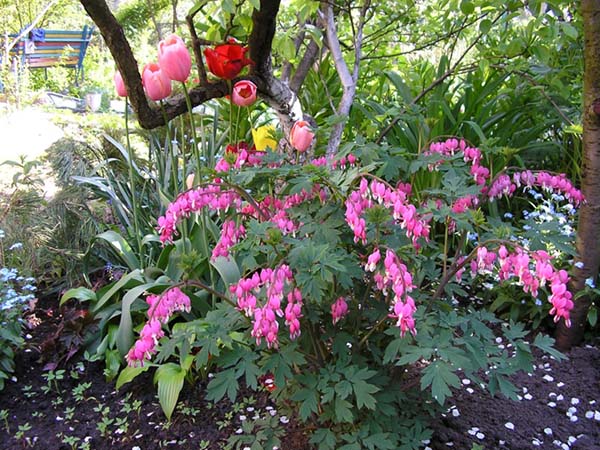
By the way! FROM other plants that love or can thrive in the shade, you can get acquainted by reading this overview material.
It should also be borne in mind that the plant does not tolerate stagnant moisture, which means that it cannot be planted in a place where melt and rainwater accumulates.
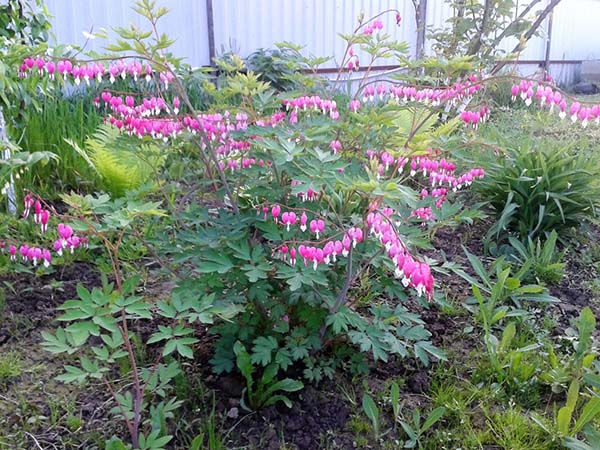
Soil and planting hole
The plant is relatively undemanding in relation to the soil, it can grow on almost any soil.But if you want the dicentra to grow faster, then, of course, the soil should be, first of all, very loose and well-drained (permeable), and in the second, fertile and preferably humus.
Therefore, it is recommended to fill the planting hole with compost or rotted manure (but not fresh). Leafy humus from the forest is also perfect, rotted sawdust... And so that the moisture does not stagnate, add sand to the soil mixture.
Dicentra grows very well on sandy soils. Just do not forget to water on time and feed periodically.
But if you have the soil is too acidic and / or boggy, then it is advisable to add to the planting pit, in addition to compost, wood ash or dolomite flour, in other words, one of soil deoxidizers. AND sandso that there was no stagnation of moisture.
Direct planting into the ground
Step-by-step instructions for planting a dicenter in open ground:
- Choose the best place on the site.
- Prepare and fill the landing pit.
- Take out the seedling and transfer it into the hole along with a lump of earth.
- Sprinkle earth on the side and compact.
- Water abundantly.
- Mulch (eg with bark) to prevent moisture from evaporating quickly.
In the next videos, a popular gardener blogger plants ready-made seedlings of dicentra in a pot (container) directly into the open ground.
In this form, it is usually sold in May, but the price is significantly higher than that of rhizomes.
Video: dicenter - planting and care in the open field
Dicenter care outdoors
The dicenter is considered to be a rather unpretentious perennial that does not require special care (you need to feed it only when necessary), although the standard procedures, of course, should be followed (watered).
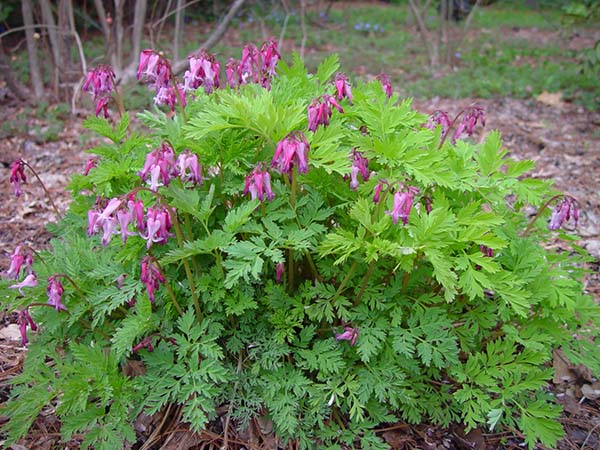
Watering and loosening
The gorgeous dicentra is very fond of watering, but in no case should it be poured, since it does not tolerate stagnant moisture (roots begin to rot). But the beautiful one is a little more drought-resistant, but again one should not make categorical conclusions - it is necessary to water it, but a little less often.
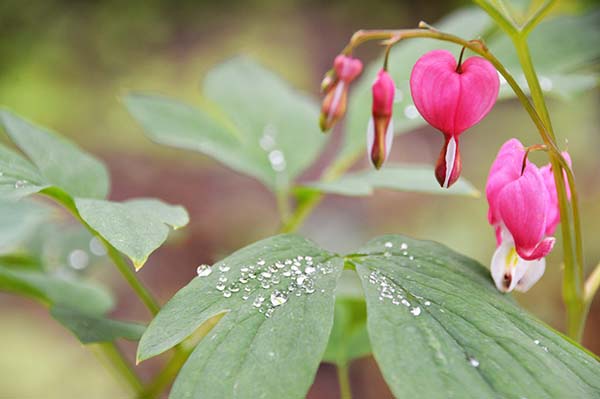
Best of all, if you mulch the plant's near-stem circle, then you do not have to loosen it and water it often. In general, the roots of the dicenter are very fond of oxygen, so you should periodically loosen the ground under the bushes.
Top dressing
The plant values organic matter very much, so it is advisable to periodically feed it with organic fertilizers (humus, mullein infusion).
By the way! If your plant grows and blooms well, then there is no point in bothering with fertilizing.
The feeding scheme is standard:
- in early spring, the plant needs nitrogen fertilizers to build up the aboveground mass (for example, you can pour mullein infusion);
- before flowering - in potash fertilizers.
- during flowering - in potassium-phosphorus.
By the way! In the fall, it is good to mulch (fertilize) the trunk circle with humus, which will begin to be absorbed by the plant only in the spring, when it will need it.
Transfer
Note! In one place the bicenter can grow well for about 15 years or even more (although there is a different opinion that it is necessary to plant it every 5-8 years). It is not necessary to transplant the shrub unnecessarily, the plant is very difficult to tolerate the transplant and will certainly hurt and take root for a long time in a new place.
As a rule, you have to replant because you need to free up space, or you want to divide the bushes.
As for the timing of the transplant, it is possible to dig out the dicenter only after flowering, and even better - when the leaves have already begun to turn yellow, i.e. in the second half of summer (beautiful) and at the beginning of autumn (beautiful).
By the way! To make it easier to replant, you can cut off the entire above-ground mass even before digging the bush.
The transplant process itself is quite complicated, because rhizomes grow very much, and they need to be dug out with a large clod of earth so as not to damage the root system.
Advice! If you damage the roots, sprinkle the cuts with crushed charcoal or wood ash.
After transplanting, it is imperative to shed the bush abundantly, and if the earth settles, then add additionally.
Video: how to transplant a dicenter (broken heart)
Pruning
As mentioned earlier, every year the aboveground part dies off at the dicenter, and in the spring it revives again. Therefore, when it fades and the foliage begins to dry out, then if you wish, you can cut the bushes under the root, leaving small hemp (about 3-7 cm).
Shelter for the winter
In the first year after planting, while the plant has not yet taken root in a new place, it is better to cover it slightly for the winter - pour dry leaves and cover with spruce branches.
In the future, the dicenter does not need any shelters, it is absolutely winter-hardy.
However! Dicenter curly better still shelter for the winter, similarly shelter of clematis.
If you want to admire the bright dicenter for your pleasure, pay more attention to the intricacies of planting and growing it in pots and open field, as well as to the peculiarities of care: watering and loosening, feeding, transplanting, pruning and sheltering for the winter.
Video: dicentra (broken heart) - an unpretentious plant for shady places in the garden

